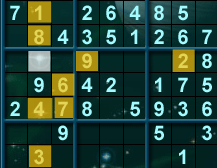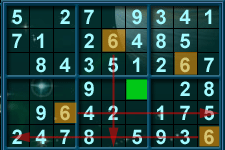The first and most important thing: DO NOT GUESS! Guessing will probably lead you the wrong way.
So try to avoid guessing and learn to solve Sudoku by reason and logic.
 Find the obvious: if there is only one number missing in a row/column/region, you can easily find the missing one. E.g. 4 in the case shown in the picture. The same can be done for rows and columns as well.
Find the obvious: if there is only one number missing in a row/column/region, you can easily find the missing one. E.g. 4 in the case shown in the picture. The same can be done for rows and columns as well.
 No other choice: there might be other empty cells in the given row, column and region, however, if you look at them together there is only one possible number remaining. Look at the image on the right side. We are looking at the empty cell highlited with white colour. 1, 4, 8, 4, 3 are excluded thorugh being in the same column, 2 and 9 are excluded for being in the same row, 6 and 7 for being in the same region. Therefore the only possible number there is 5.
No other choice: there might be other empty cells in the given row, column and region, however, if you look at them together there is only one possible number remaining. Look at the image on the right side. We are looking at the empty cell highlited with white colour. 1, 4, 8, 4, 3 are excluded thorugh being in the same column, 2 and 9 are excluded for being in the same row, 6 and 7 for being in the same region. Therefore the only possible number there is 5.
 Intersection: Have a look at the lower center region on the image to the right. It has 4 empty cell. The region must contain all numbers, including "6". We have highligted all the 6's on the board. You can see that there is only one possible cell for 6 in that region, marked by green, since putting it in any other cell would conflict with one (or more) of the other 6's.
Intersection: Have a look at the lower center region on the image to the right. It has 4 empty cell. The region must contain all numbers, including "6". We have highligted all the 6's on the board. You can see that there is only one possible cell for 6 in that region, marked by green, since putting it in any other cell would conflict with one (or more) of the other 6's.
You should be able to solve EASY sudoku's using these basic techniques. However for more difficult ones you will need some more advanced strategies.